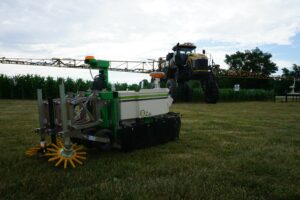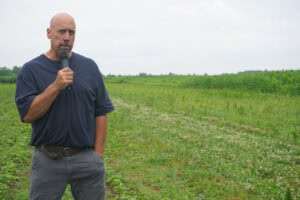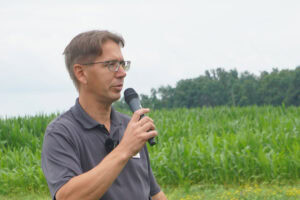Finding and overcoming field robot limitations

A new field robot design might look good on paper, and it may even work under lab conditions or specific field settings. Change the conditions in which it has to operate, though, and things can get tricky.
In Ontario, an autonomous working group comprised of agribusinesses, farmers, robotics companies, agricultural extension experts, university researchers and others has been putting an array of field robots through the ringer. The goal is twofold – to determine what hardware and software adaptations are required for each machine to perform well in differing Ontario conditions, and what logistical challenges have to be overcome for practical operation.
Haggerty Creek Ltd, the Ontario agribusiness and robotic equipment dealer leading the working group initiative, held a multi-site demonstration event in mid-July, 2022. The accomplishments – and yet-to-be-solved failings – of several machines were exhibited.
Naïo Oz

Origins and abilities: Designed by French company Naïo Technologies, Naïo Oz is a small in stature machine currently serving as a tillage robot, seen here after working between corn rows. Chuck Baresich, general manager of Haggerty Creek and a driving force behind the overall robotics research project, considers the machine both useful and adaptable. Indeed, it’s strengths come down to how creative the operator can be in augmenting the machine with different implements.
Challenges: For such a small robot, it moves quite slowly. Varying soil types (particularly heavy soils) can also pose a problem for its tillage implements. Mobility in high residue levels and excess moisture is a problem. This latter issue is exacerbated in the humid, dew-heavy early mornings and later evening of Southwestern Ontario summers, meaning operation times can be constrained. Corn stalks can also look like humans to its optical sensors, and thus, an obstacle requiring the cessation of operations.
The Goat (Nexus)
Origins and abilities: As its name implies The Goat from Quebec-based Nexus Robotics is designed to graze. The mechanical weeding robot runs on an electric hybrid motor, and can operate 24-7 at varying speeds based on weed pressure and field size. It’s three independent weeding arms are directed by cameras within the unit’s main cavity.
Challenges: Demonstration attendees and presenters both considered the on-site model – one of six being trialed across Canada – to be pretty slick in appearance. But as Baresich describes, the machine is still an early prototype requiring plenty of refinement. It moves very slowly, particularly in the weed-heavy demonstration plot.
The arms are not always effective at their weed-removal job. It also has a rather loud generator for its electric engine – something which Baresich finds irksome and unnecessary – and the fact that its entire operation is actually controlled by company operators at their Montreal headquarters could be a barrier for many growers.
RoamIO HC
Origins and abilities: The RoamIO-HCW is modeled on an earlier, smaller, golf-course focused RoamIO machine. It is designed and manufactured by Korechi Innovations Inc. and Haggerty AgRobotics is the first customer and has provided invaluable design inputs for the same. The Ontario company worked with Baresich and his colleagues to develop an autonomous unit which can do a variety of tasks. Or more specifically, they developed an autonomous chassis which, like the Naïo Oz, can be outfitted with different implements.

During the demonstration event, local grain grower and active cover cropper Woody Van Arkel showed how he uses the RoamIO-HCW to mow perennial cover between crop rows (the machine pictured here shows the mower deck raised). Both Baresich and Van Arkel expressed enthusiasm for its performance, and the possibility of accomplishing other tasks.
Challenges: The demonstration model looks unfinished – because it is unfinished. Baresich says limited time has thus far gone into making the machine “look pretty,” the team opting instead to emphasize functionality. RoamIO-HCW has generally been given the most attention, and is considered one of the more practical robots at this point.
After writing this article, we received a video from Korechi Innovations showing the finished version of the RoamIO-HCW, which can be seen in the second video below.
Text continues below videos
The video below shows the RoamIO-HCW as final product
Logistics, cost, and refinement
The working group is testing a variety of other robots, although geographical limitations and the production needs of participating farmers prevented their showcasing at the demonstration event.

Overall, Baresich and fellow members of the autonomous working group emphasized their goals are not to simply highlight flaws with different autonomous equipment designs. The idea is to find limitations, troubleshoot, and overcome them – in essence, prove machines can work in an Ontario environment, and that investing in autonomous equipment will be a viable option for more farmers in future.
“I’ve always been interested in trying to improve production systems. How can we practice with and develop this technology? Believe it or not this technology doesn’t work right out of the box,” says Baresich, adding broad acreage crop farming (particularly grain) is the last frontier for automation because it’s the most challenging.
We’re going to need a fleet. One robot can’t do everything
Logistical considerations and constraints also underlay the entire conversation. “For example, with an autonomous robot you have to charge it somewhere. It’s fine to say I’m going to have a machine that can do 10 acres a day, but if I put this in a 100-acre field that’s 10 miles away from my dry shed and no buildings around, how am I going to charge this thing? The reality is, to say I’m going to load it on a trailer to drive it back home every night, charge it, and bring it back the next morning – that’s never going to happen. Farmers are too busy, it’s not a realistic expectation…We also have to solve the logistics piece. How do you charge them? How do you fix them? What errors happen? All these types of questions.”
Do you want to know what field robots are currently available? Check out our Field Robots Catalogue, with all currently availabe field robots, including technical specifications, photos, videos and more!
Join 17,000+ subscribers
Subscribe to our newsletter to stay updated about all the need-to-know content in the agricultural sector, two times a week.



